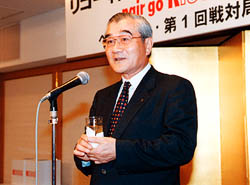|
Are they Afraid of the New System? The meeting began with opening speeches by Mr. Ichiro YOSHIKUNI, Chairman of the Japan Pair Go Association, and Mr. Hiroshi HAMADA, Representative Director and Chairman of Ricoh Co., Ltd. They expressed their actual feeling that this event had been progressively becoming prosperous. gAt first, I worried if pro players would appreciate the significance of Pair Go.h (Mr. Yoshikuni) gI have been happy there has been no absence due to sickness.h (Mr. Hamada) |
| It is true that the pro Go circle was embarrassed when the Ricoh Cup championship started. In contrast to the traditional Go game with a serious atmosphere, gsociablenessh is a unique feature of the new Go game. It may be natural for pro players to be bewildered by Pair Go because they are involved in a world of severe competition. However, such embarrassment or leisure mood has almost disappeared. The meeting made me feel that Pair Go was taking root among pro players. Menfs eagerness also was considered to be a sign of this. |
| During the meeting, the person who most attracted male playersf attention was 8-dan Ms. Kazuko SUGIUCHI although this may sound strange to amateur fans. As a matter of fact, the atmosphere of the hall sharply got tensed when Ms. SUGIUCHIfs partner became clear by lottery. This perplexed reporters including myself. But I realized soon that the system newly introduced had caused such tension. |
|
| et me briefly explain the new system. Under the former system for the Ricoh Cup championship, the four pairs whichwin both the first and second round games straight are to unconditionally advance to the quarterfinals, while the eight pairs which win one game and lose one game are to compete in the revival games. And the four pairs which win the revival games are to become the remaining quarterfinalists. That is, the pairs which win one game and lose one game have to play three games a day. However, it is said that playing three games a day is exhausting for top pro players (veteran male players, in particular). For the spectating fans, it is also harder than you can imagine to keep standing while watching three games. To cope with this problem, the new system has been introduced. In this system, out of the eight pairs winning one game and losing one game, the four older pairs are to automatically advance to the quarterfinals. This means that pairs may advance to the quarterfinals with only one win if the combined age of the paired players is higher. This is why the oldest female player became the focus of male playersf attention. |
| Professional gSeriousnessh It may be bad manners for men to pay attention to womenfs ages especially in Pair Go that is a sociable game. I think that male players knew the rudeness. Still, they revealed their wish to pair with 8-dan Ms. SUGIUCHI, the oldest female player. From their attitude, I perceived pro playersf seriousness rather than easiness. I got a glimpse of real professionalism or the will to win. |
| Needless to say, such seriousness must be particular to pro players. I feel that it is important for amateur players to enjoy partnership or mental communication between the paired players regardless of winning or losing games. Possibly, a unique world of pro playersf Pair Go may be emerging as a new stream. Or it can be said that a new field is being opened in Pair Go as male players appeared to be in earnest to win. |
| About Pair Go, mental techniques including good partnership has been often mentioned. However, serious games between pro players may lead to technical pursuit of this game on boards. In this sense, the upcoming Ricoh Cup championship may produce something new toward the 21st century. The atmosphere of the meeting made me have such prospects though this is a mere assumption. |

